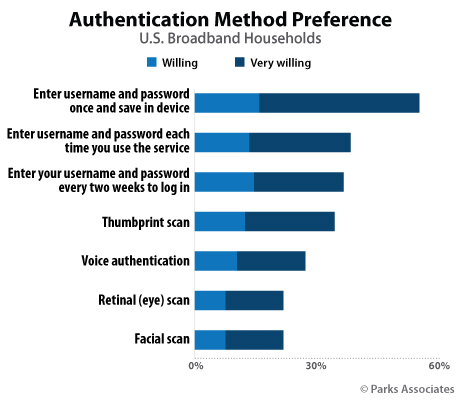16% of U.S. broadband households share online video passwords
Wednesday, January 16th, 2019
16% of U.S. broadband households share their passwords for their online video service accounts
- New report profiles major players that provide authentication and identification technologies
DALLAS — Research from Parks Associates finds 16% of U.S. broadband households admit to sharing their passwords for their video service accounts with other people. Innovations in Authentication and Personalization Technologies reports that service providers will have a difficult time moving subscribers to new methods of password-free authentication. Only one-third or fewer of U.S. broadband households are willing to use a non-password authentication method such as voice or thumbprint, while 54% of U.S. broadband households are willing or very willing to enter a username and password once and save it on a device.

“Passwords represent risk for both users and service providers due to piracy and password sharing, but the password concept is ingrained in consumers’ conception of the online video experience,” said Billy Nayden, Research Analyst, Parks Associates. “The push to staunch password sharing and piracy is driving initiatives where each interaction is graded based on prior user behavior, using data points like geography, time, and watching behavior. Grading ensures that interactions that need a high level of security receive it while routine interactions allow users a frictionless experience. The authentication process will become virtually invisible to users, except when they attempt to access services outside their normal behavior.” Password managers like LastPass and physical security keys are currently fulfilling the need for better management and security around passwords. Google entered the physical security key market in 2018, to compete with major players Yubico and Feitian.
“To drive adoption of new authentication methods, the industry needs to deliver a frictionless user experience, bringing a more personalized approach to authentication in addition to increased security,” Nayden said. “Poor experiences with authentication and personalization technologies will drive consumers back to traditional methods and increase churn for video services. The smartphone will be one of the gateway devices toward a more biometric approach to user authentication—the top 15 smartphone models in the U.S. all have some form of biometric technology.”
Innovations in Authentication and Personalization Technologies explores the readiness of new personal identification and authentication technologies for market deployment, analyzes best-fit use cases, and profiles major players that provide authentication and identification technologies or solutions.
Additional research from the report includes:
- 62% of consumers indicate they are very concerned about someone hacking an online service and obtaining their personal information.
- 14% of respondents using a smart device or app with a personal assistant say that asking for information on scheduling for programs on TV is their most desired function with voice control.
Latest News
- Barb to start reporting TV-set viewing of YouTube channels
- SAT FILM selects multi-DRM from CryptoGuard
- Qvest and ARABSAT to launch OTT streaming platform
- ArabyAds & LG Ad Solutions partner with TVekstra in Turkey
- Freeview NZ satellite TV service to move to Koreasat 6
- Comscore expands YouTube CTV measurement internationally
